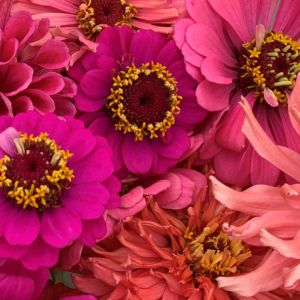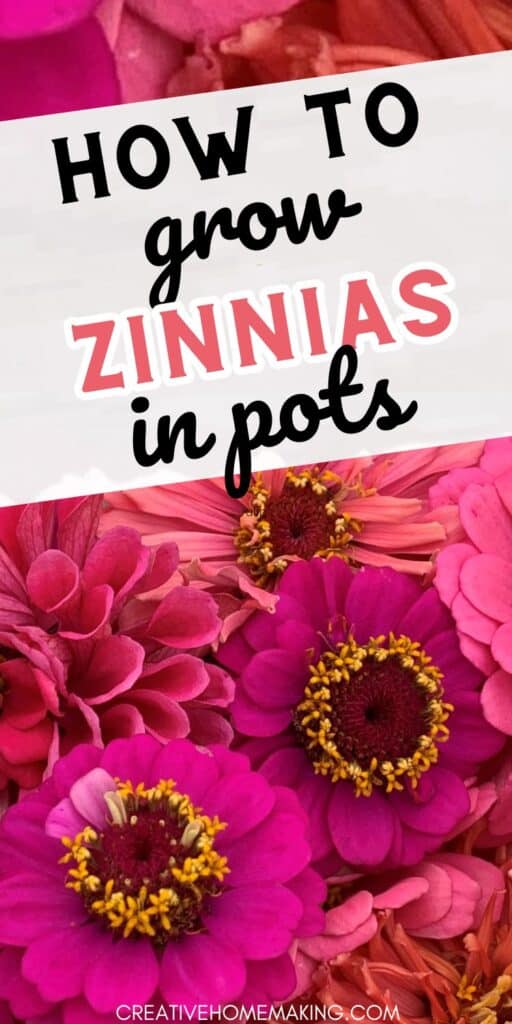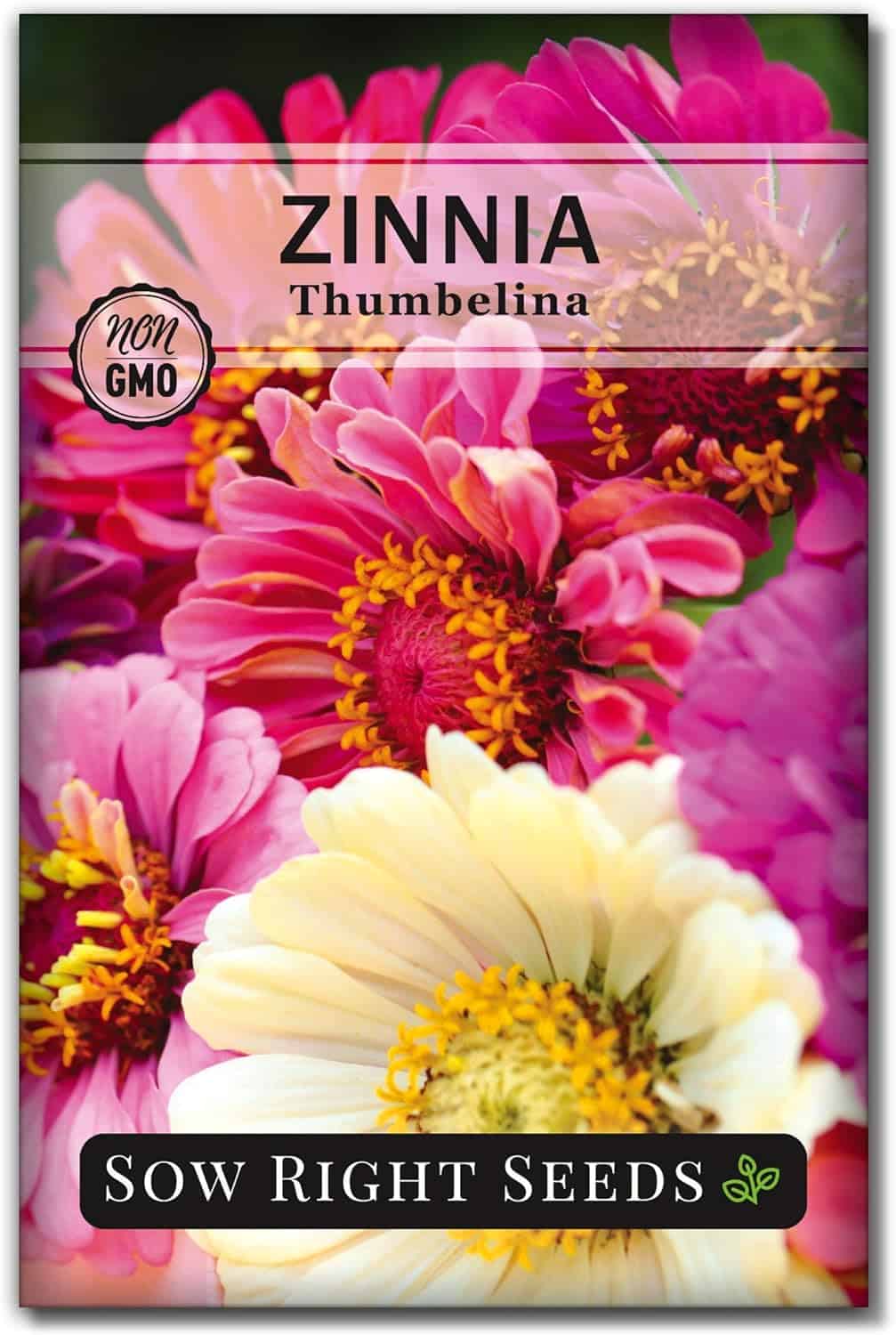Are you looking for a way to add some color to your outdoor space? Zinnias are a beautiful and easy-to-grow option that can add a pop of color to any garden.
This post may contain affiliate links.
While zinnias are typically grown in garden beds, they can also thrive in pots. In this article, we will show you how to grow zinnias in pots so that you can enjoy their vibrant blooms all summer long.
Growing zinnias in pots is a great way to add color to your patio, balcony, or any outdoor space. With the right care and attention, zinnias can thrive in containers and produce beautiful blooms that will brighten up your day.
In this article, we will cover everything you need to know to successfully grow zinnias in pots, from selecting the right container to caring for your plants throughout the growing season.
So, whether you are an experienced gardener or a beginner, read on to learn how to grow zinnias in pots and enjoy their colorful blooms all season long.
Related Article: When to Pinch Zinnias: A Quick Guide
Choosing the Right Zinnia Varieties and Pots
When it comes to growing zinnias in pots, choosing the right varieties and pots is crucial for their growth and overall health. In this section, we will discuss some important factors to consider when selecting zinnia varieties and pots.
Related Article: How to Grow Geraniums from Cuttings
Selecting Zinnia Varieties
Zinnias come in a wide range of colors, sizes, and shapes, which makes them a popular choice for gardeners. When selecting zinnia varieties, it’s important to consider the size of your pot and the amount of sunlight it will receive.
Dwarf varieties, such as the Thumbelina Mix, are perfect for small pots and can thrive in partial shade. On the other hand, if you have a larger pot and plenty of sunlight, you may want to consider taller zinnia varieties such as the Giant Cactus or the State Fair Mix.
Related Article: How to Save Seeds from Zinnias: A Beginner’s Guide
Types of Containers for Zinnias
Choosing the right pot for your zinnias is just as important as selecting the right variety. When it comes to containers for zinnias, there are a few things to keep in mind.
First, make sure your pot has good drainage. Zinnias don’t like to have their roots sitting in water, so it’s important to choose a pot with drainage holes. You may also want to consider adding a layer of gravel or sand to the bottom of your pot to improve drainage.
Related Article: How to Deadhead Zinnias: A Friendly Guide
Second, make sure your pot is large enough to accommodate your zinnia variety. As a general rule, your pot should be at least 6 inches deep and 6 inches wide for dwarf varieties, and at least 8 inches deep and 8 inches wide for taller varieties.
Lastly, consider the material of your pot. Clay pots are a popular choice for zinnias because they are porous and allow for good airflow. However, plastic pots are also a good option as they are lightweight and easy to move around.
Preparing for Planting
Before you start growing zinnias in pots, you need to prepare the planting area. Here are some tips to help you get started:
Soil and Compost
Zinnias grow best in well-draining soil that is rich in organic matter. You can use a commercial potting mix or make your own by mixing equal parts of peat moss, perlite, and vermiculite. You can also add compost to the mix to provide extra nutrients for the plants.
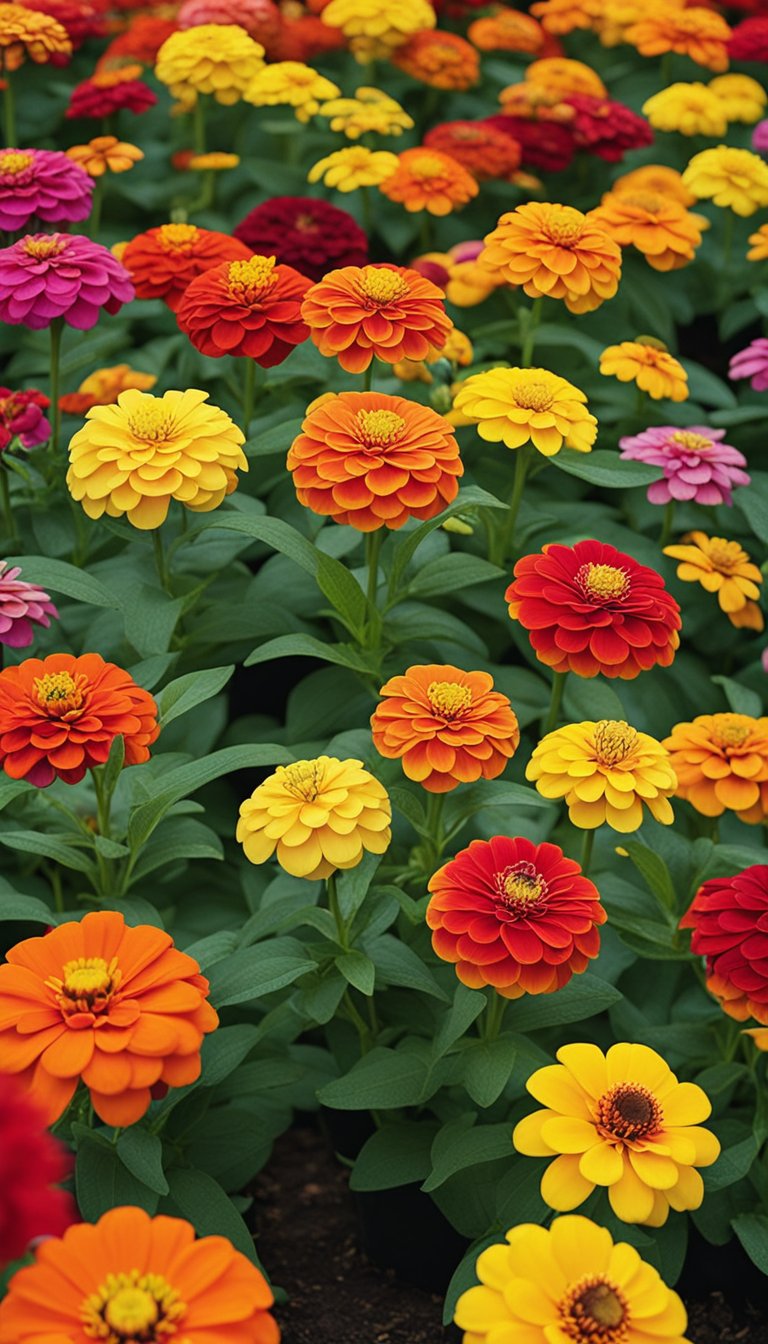
Seed Germination
Zinnias can be grown from seeds. To germinate the seeds, you need to provide them with a warm and moist environment. You can start the seeds indoors in a seed tray or directly in the pot.
Fill the tray or pot with the prepared soil mix and sow the seeds on top. Cover the seeds lightly with soil and water gently.
Related Article: How to Grow Geraniums in Containers
To speed up germination, you can soak the seeds in water for a few hours before planting. You can also cover the pot with plastic wrap or a clear plastic bag to create a mini greenhouse. Keep the soil moist but not waterlogged and place the pot in a warm and bright location.
By following these tips, you can prepare the soil and germinate the seeds for your zinnia pot. With a little patience and care, you can enjoy a beautiful display of zinnias in your home or garden.
Planting and Caring for Zinnias
Zinnias are beautiful and easy-to-grow flowers that can brighten up any garden or patio. They come in a wide range of colors and sizes, making them a popular choice for gardeners and flower enthusiasts. Here are some tips on how to plant and care for zinnias in pots.
Planting Zinnias in Pots
When planting zinnias in pots, choose a container that is at least 6 inches deep and has drainage holes at the bottom. Fill the pot with well-draining soil and plant the zinnia seeds about 1/4 inch deep. Water the soil thoroughly but avoid overwatering, as this can cause the seeds to rot.
Once the seeds have sprouted and the plants have developed their first set of true leaves, thin them out to about 6 inches apart. This will give each plant enough space to grow and thrive. Zinnias prefer full sun, so make sure to place the pots in a sunny location.
Watering and Fertilizing
Zinnias need regular watering, especially during hot and dry weather. Water the plants when the top inch of soil feels dry to the touch. Avoid getting water on the leaves, as this can cause fungal diseases. If you notice any signs of wilting or yellowing leaves, increase the frequency of watering.
To encourage healthy growth and blooming, fertilize the zinnias every two weeks with a balanced fertilizer. Follow the instructions on the package for the correct amount and frequency of application.
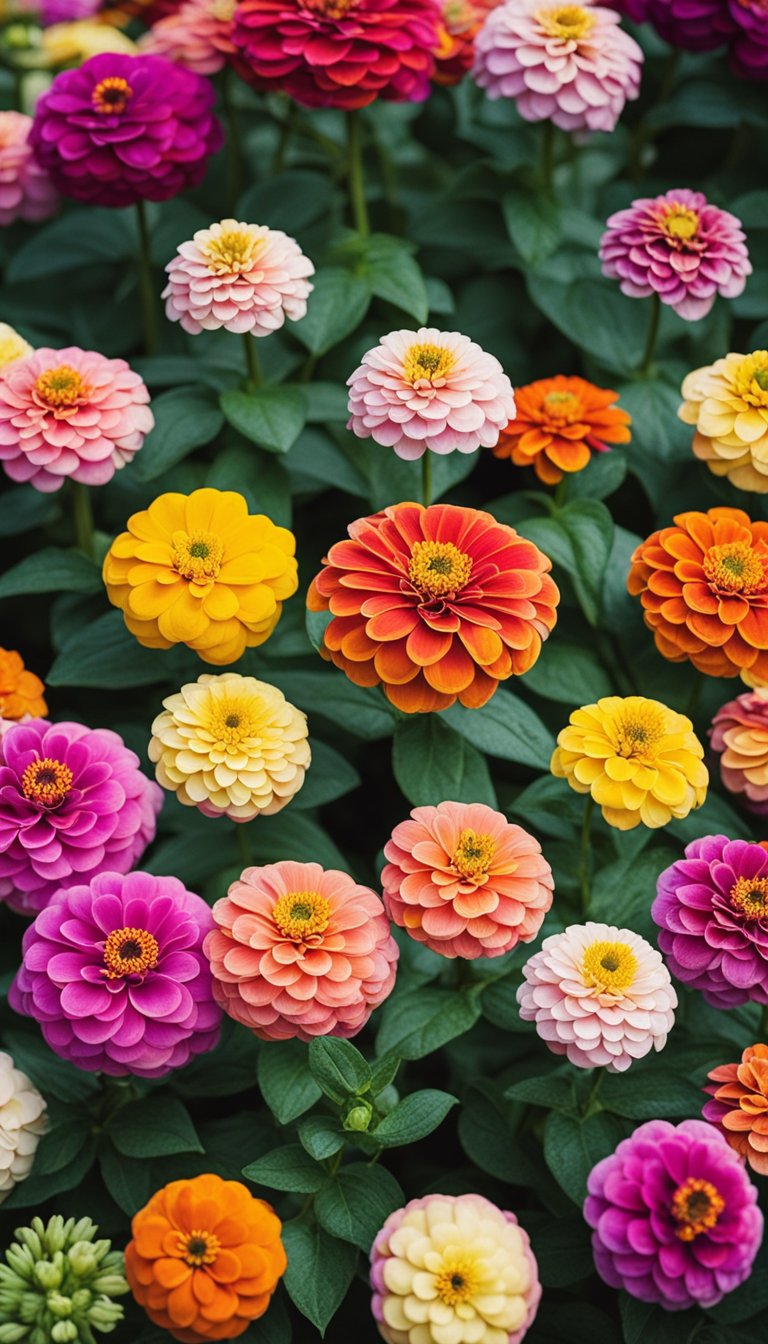
Sunlight and Temperature
Zinnias thrive in full sun and warm temperatures. They can tolerate some shade, but too much shade can cause the plants to become leggy and weak. Make sure to place the pots in a location that receives at least 6 hours of direct sunlight per day.
Zinnias can also tolerate high temperatures, but they may require more frequent watering during heatwaves. If the temperature drops below 50°F (10°C), consider bringing the pots indoors or covering them with a frost cloth to protect the plants.
Maintaining Healthy Growth
Growing zinnias in pots can be a rewarding experience, but it’s important to take good care of them to ensure healthy growth. Here are some tips to help you maintain your zinnias:
Pruning and Deadheading
Pruning and deadheading are important tasks that will help your zinnias grow strong and healthy. Deadheading is the process of removing dead flowers from your plants, which will encourage them to produce more blooms.
Pruning, on the other hand, involves cutting back the stems of your zinnias to promote bushier growth.
To deadhead your zinnias, simply use a pair of sharp scissors or pruning shears to cut off the dead flower just above the first set of leaves. To prune your zinnias, cut back the stems by about one-third, making the cut just above a set of leaves. This will encourage your zinnias to produce more branches and blooms.
Disease and Pest Prevention
One of the biggest threats to your zinnias is disease and pests. To prevent these problems, it’s important to keep your plants healthy and well-maintained. Here are some tips to help you prevent disease and pests:
- Provide good air circulation around your zinnias by spacing them out and avoiding overcrowding.
- Water your zinnias at the base of the plant to prevent powdery mildew and other fungal diseases.
- Keep an eye out for aphids, which can be controlled with insecticidal soap or neem oil.
- Fungus can be prevented by avoiding overhead watering and ensuring good air circulation.
By following these tips, you can help ensure that your zinnias grow strong and healthy in their pots.
Enjoying Your Blooms
Congratulations! Your zinnias are blooming beautifully in their pots. Here are some tips to help you enjoy your blooms even more.
Attracting Pollinators
Zinnia flowers are a favorite of pollinators such as butterflies, bees, and hummingbirds. To attract these beneficial creatures to your zinnia blooms, consider adding other pollinator-friendly plants to your garden or balcony. Some examples include milkweed, coneflower, and bee balm.
Transplanting and Winter Care
If you want to transplant your zinnias to larger pots or into the ground, wait until after the last frost date in your area. Zinnias prefer well-draining soil and full sun. When transplanting, be sure to water the plants thoroughly and add a layer of mulch around the base to help retain moisture.
In colder climates, zinnias may not survive the winter outdoors. To overwinter your zinnias, consider bringing them indoors and placing them near a sunny window.
Water sparingly and avoid fertilizing during the winter months. When spring arrives, you can transplant your zinnias back outdoors.
Frequently Asked Questions
What is the best way to plant Zinnia seeds in pots?
To plant Zinnia seeds in pots, fill the container with a good quality potting mix and sprinkle the seeds on top. Lightly cover the seeds with a thin layer of soil and water gently.
Keep the soil moist until the seeds germinate, which usually takes 7-14 days. Once the seedlings have grown a few inches tall, thin them out to ensure they have enough space to grow.
Are Zinnias suitable for growing indoors in containers?
Yes, Zinnias can be grown indoors in containers as long as they receive enough sunlight. Choose a bright spot near a window and make sure the pot is not too large for the space. Zinnias prefer warm temperatures, so keep the room temperature between 65-75°F (18-24°C).
How can I ensure my potted Zinnias receive adequate sunlight?
Zinnias require at least 6 hours of direct sunlight per day to thrive. Place the pot in a sunny spot, preferably facing south or west. If you’re growing Zinnias indoors, consider using a grow light to supplement natural light.
What are the watering requirements for Zinnias in containers?
Zinnias prefer well-draining soil and do not like to sit in water. Water the plant when the top inch of soil feels dry to the touch. Be careful not to overwater, as this can cause root rot. In hot weather, you may need to water more frequently.
How do I properly deadhead Zinnias to encourage more blooms?
Deadheading is the process of removing spent flowers to encourage the plant to produce more blooms. To deadhead Zinnias, simply pinch off the flower head just above the first set of leaves. This will redirect the plant’s energy to producing new flowers instead of producing seeds.
Which Zinnia varieties are recommended for growing in pots?
Zinnias come in a variety of colors and sizes, but some varieties are better suited for growing in pots than others. Dwarf varieties like ‘Thumbelina’ and ‘Lilliput’ are compact and perfect for small containers.
‘Profusion’ series and ‘Zahara’ series are also good choices for container gardening as they are disease-resistant and produce an abundance of blooms.
Follow my zinnia garden board on Pinterest.
